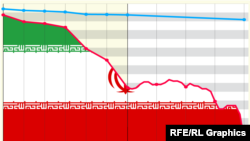Iran’s national currency, the rial, has once again passed the record-breaking point of 120,000 against the U.S. dollar.
The gold market was also turbulent on September 2, when the value of the official gold coin reached 44 million rials (roughly $1,000 at the official rate).
According to the state-run Iran Student News Agency (ISNA), the reason for the rapid drop of the rial was the rising demand for gold and the dollar.
ISNA reported that even exchange bureaus that offer subsidized foreign exchange under Central Bank of Iran (CBI) regulation, including dollars for medical and educational purposes, sold $1 for almost 120,000 rials, while one euro was exchanged for 137,000 rials.
Iranian financial markets have been faltering in recent months to the extent that the issue led protests held by Tehran’s Grand Bazaar merchants, who traditionally support the ruling conservative clergy.
The new foreign exchange policy announced by President Hassan Rouhani’s administration on August 7 mitigated the situation and pushed the dollar’s value below 100,000 rials, but only for a few days.
Now, with a new CBI governor in place and the finance minister’s sacking, the rial’s nosedive and skyrocketing gold prices have gained momentum again.
The new governor of the CBI reiterated on September 1 that the country's foreign currency reserves will not be used to support the exchange rate of the national currency.
Abdolnasser Hemmati, the new CBI governor, said the bank's foreign reserves are its "honor" and should not be used during "an economic war" with the United States.
The Iranian currency, which started to decline in 2017, has taken a beating in the past few months since the U.S. announced its withdrawal from the nuclear deal and re-imposed stringent sanctions on Iran's economy.
In 1945, Iran switched to the U.S. dollar as the peg for its national currency, with 1 dollar against 32.25 rials. The value of the rial, through the last decades of Shah Mohammad Reza’s reign, remained fixed at almost 70 rials per dollar.
Almost 36 years later, when Rouhani assumed office in 2013, a dollar bought 36,000 rials.
A steep plunge in the value of the rial has led to a spike in demand for dollars in recent months from Iranians seeking safer assets, the Wall Street Journal report on August 28. On the same day, one U.S. dollar bought 107,000 rials, compared with 43,000 rials in January.
Rouhani recently told the Iranian Parliament that he had ordered the CBI not to use oil revenues to support the rial.
However, the declining currency has led to higher inflation, with most necessities substantially becoming more expensive for the people, who have been frustrated by dire economic conditions including high unemployment and a soaring cost of living.
The widespread dissatisfaction has led to rounds of nationwide mass protests this year, which have turned into calls for regime change.
With this kind of tension in society, it is not clear how long the government can afford to save its oil income and not intervene in the markets.





